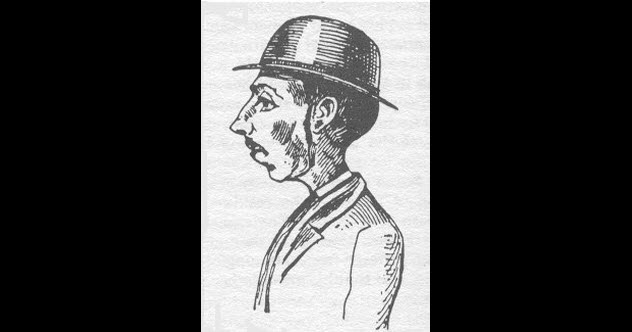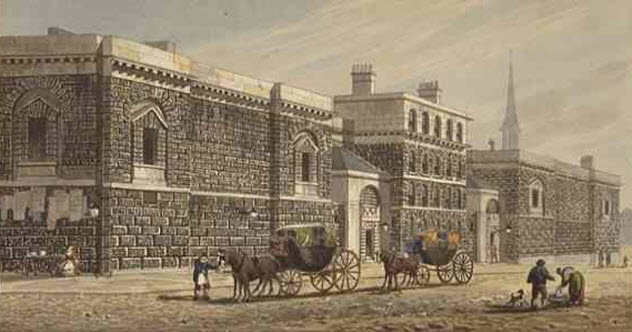 Our World
Our World  Our World
Our World  Movies and TV
Movies and TV The 10 Coolest Stars to Set Sail on The Love Boat
 History
History 10 Things You Didn’t Know About the American National Anthem
 Technology
Technology Top 10 Everyday Tech Buzzwords That Hide a Darker Past
 Humans
Humans 10 Everyday Human Behaviors That Are Actually Survival Instincts
 Animals
Animals 10 Animals That Humiliated and Harmed Historical Leaders
 History
History 10 Most Influential Protests in Modern History
 Creepy
Creepy 10 More Representations of Death from Myth, Legend, and Folktale
 Technology
Technology 10 Scientific Breakthroughs of 2025 That’ll Change Everything
 Our World
Our World 10 Ways Icelandic Culture Makes Other Countries Look Boring
 Our World
Our World 10 Ways Your Christmas Tree Is More Lit Than You Think
 Movies and TV
Movies and TV The 10 Coolest Stars to Set Sail on The Love Boat
 History
History 10 Things You Didn’t Know About the American National Anthem
Who's Behind Listverse?

Jamie Frater
Head Editor
Jamie founded Listverse due to an insatiable desire to share fascinating, obscure, and bizarre facts. He has been a guest speaker on numerous national radio and television stations and is a five time published author.
More About Us Technology
Technology Top 10 Everyday Tech Buzzwords That Hide a Darker Past
 Humans
Humans 10 Everyday Human Behaviors That Are Actually Survival Instincts
 Animals
Animals 10 Animals That Humiliated and Harmed Historical Leaders
 History
History 10 Most Influential Protests in Modern History
 Creepy
Creepy 10 More Representations of Death from Myth, Legend, and Folktale
 Technology
Technology 10 Scientific Breakthroughs of 2025 That’ll Change Everything
 Our World
Our World 10 Ways Icelandic Culture Makes Other Countries Look Boring
10 Historical British Railway Murders
The first locomotive-powered public railway in Britain opened in 1825, making it the oldest railway system in the world. With almost 200 years of history, it has seen more than its fair share of notable events, both good and bad. Just about every evil deed imaginable has been committed on the British railway system at one point or another, and murders have proven to be quite bountiful.
10 Murder In Balcombe Tunnel

On June 27, 1881, coin dealer Isaac Gold was traveling from London to his home in Brighton. He was sitting in a first-class smoking compartment when he was joined by a man named Percy Lefroy Mapleton.
When the train reached Preston Park Station in Brighton, Mapleton got out. He looked completely distraught and was covered in blood. He had just murdered Gold and dumped his body out of the moving train. When questioned, Mapleton claimed to have been the victim of an attack, but an unconvinced constable brought him to the local police station.
At this point, police thought that Mapleton was trying to cover up a suicide attempt, which was a criminal offense. There were too many lingering questions about his story. If not in the station, where did his assailant(s) get off the train? Why was Mapleton covered in blood when he only had a few minor injuries? Why did he have a gold watch in his shoe?
The gold watch was actually the only remaining prize that Mapleton still had from Gold. He also took the coin dealer’s purse and wallet but disposed of them down the pipes in the police station bathroom. Eventually, the police sent Mapleton back to London, escorted by a detective sergeant.
In the meantime, Gold’s body was found in Balcombe Tunnel with a watch chain around his neck. When police finally made the connection, Mapleton was already on the run. Using his description, the Daily Telegraph released the first criminal sketch (shown above) to the public. This led to Mapleton’s arrest and conviction.
9 Britain’s First Private Execution

It’s hard to say exactly what the relationship was between Edward Walsh, the station master at Dover Priory Station, and one of his employees, a porter named Thomas Wells.
According to Walsh, Thomas Wells was a lazy worker with an attitude problem. As far as Wells was concerned, his boss picked on him for no reason and often abused his authority by making him run personal errands.
On May 1, 1868, Walsh summoned the 18-year-old porter to his office where Area Superintendent Henry Cox was also present. Walsh once again reprimanded Wells for his work and demanded that he apologize or face dismissal.
This turned out to be the straw that broke the camel’s back. Wells went back to his work area where he kept a concealed gun, supposedly for shooting birds. He then walked back into Walsh’s office and shot him point-blank in the head.
Realizing what he’d done, Wells made a desperate attempt to hide in an empty train carriage. But he was found and arrested minutes later. His defense counsel tried pleading temporary insanity, but it was no use. Thomas Wells was convicted and executed on August 13, 1868.
As it happened, Britain had just passed the Capital Punishment (Amendment) Act that June. Under the new law, all executions were to occur inside prisons away from the public. Thomas Wells became the country’s first privately executed criminal, although many journalists were still on hand to witness and write about the execution.
8 Murder Of John Nisbit

On March 18, 1910, the body of John Nisbit was found on the train traveling between Newcastle upon Tyne and Alnmouth. He had been shot in the head.
Nisbit was a clerk working for the Stobswood Colliery Company. He was carrying a bag with the week’s wages, which were valued at £370. The bag was missing, which made robbery the obvious motive for the murder.
It didn’t take long for police to find a suspect. Several people pointed at a John Dickman, who had traveled with Nisbit for part of the journey. Dickman was brought in, and he admitted to being on the same train. But he denied the murder.
Police searched his home and found bloodstained clothes and gold sovereigns. Later, he was picked out of a lineup by people who claimed to have seen him with Nisbit. Dickman was charged, convicted, and executed on August 9, 1910.
Although the case might have seemed open-and-shut, many people felt that the evidence pointing at Dickman was circumstantial at best and that a better defense counsel could have avoided a conviction.
For starters, Nisbit had two different caliber bullets inside him, suggesting two shooters. Moreover, none of the witnesses could definitively place Nisbit and Dickman in the same compartment at the same time. In addition, the gold and the bloodstained clothes found in Dickman’s apartment could have easily come from different, unrelated sources.
The lingering doubt was enough to cause mass protests defending Dickman’s innocence, but nobody else was ever investigated for the murder.
7 The Railway Thieves Who Turned Into Murderers

In 1895, the town of Wigan had a problem with a series of nighttime thefts that targeted wagons parked in the train station. Policemen were deployed on stakeouts at the train depot to catch the thieves red-handed.
On September 3, Manchester detectives Robert Kidd and William Osborne were standing guard. After hiding out of sight for about an hour, the pair got bored and started to patrol the station.
They heard noises coming from nearby. After investigating, they found a man trying to remove the tarpaulin off a wagon. They tried to arrest the suspect, but several more men jumped from the shadows and attacked the officers with knives and cudgels.
A railwayman found the wounded detectives, and they were rushed to the hospital. Robert Kidd had been stabbed numerous times and eventually died of his injuries.
A large police force descended from Manchester to search for his killers. They started with the slums at Kay’s Houses. It didn’t take long for police to come up with several possible suspects. The recuperating Detective Constable Osborne positively identified three of them as his attackers: Elijah Winstanley, William Kearsley, and William Halliwell.
Halliwell quickly turned state’s evidence against his partners in crime and was charged only with attempted robbery. Kearsley and Winstanley were sentenced to death.
When Winstanley insisted that he had committed the murder alone, Kearsley’s sentence was commuted to life in prison. Elijah Winstanley was hanged on December 17, 1895.
6 Murder Of William Pearson

On January 17, 1901, Rhoda King got on the train traveling to London. As she sat in an empty third-class compartment, she was soon joined by a burly 23-year-old man named George Parker and then an older gentleman named William Pearson. Other than Mrs. King giving Parker occasional glances to admire his towering physique, the three passengers ignored each other and rode in silence.
Unknown to his companions, George Parker was a violent criminal who was always looking for a good opportunity to make money. He sized up the sleeping Pearson and concluded that the old man probably had money on him and would make an easy target.
After going to the lavatory, Parker returned with a revolver in hand and shot Pearson point-blank in the left eye. Before she realized what had happened, Rhoda King had also been shot. Fortunately for her, the bullet passed through her cheek and lodged below her jaw, causing minimal damage.
After emptying Pearson’s pockets, Parker had to decide what to do with King. Despite just being shot in the face, the woman didn’t panic. She kept talking to Parker, trying to calm him down. On her advice, Parker threw the gun out the window. At one point, he even gave her a handkerchief to stop the bleeding from her cheek.
Parker tried to escape at the next station, but it was no use. Once King sounded the alarm, several men gave chase and overpowered him. He later lamented that he might have gotten away if he had killed Rhoda King, too.
Parker was subsequently tried and executed.
5 The Strange ‘Murder’ Of Arthur Mead
On February 3, 1936, a train was traveling from Aylesbury to Paddington. While making his rounds, the guard saw a passenger who looked ill. Concerned for the man’s health, the guard moved him to a waiting room to be examined by a doctor at the next stop.
The examination revealed a shocking discovery—the man had been shot. Once the police arrived, the doctor alerted them that the man would die soon. Before his passing, he briefly regained consciousness and managed to give his statement.
His name was Arthur Mead. He had been sitting alone in a carriage when he was joined by a stranger. At one point, without saying anything, the other man had come close and shot Mead. Unfortunately, Mead died soon after giving his declaration.
An investigation was undertaken to find his killer. The murder weapon was found to be a humane killer gun used for slaughtering animals. Then a witness named Violet Fuller came forward. She had heard the sharp crack of the gun right after the train had left Risborough Station. She also said that nobody had entered or left that compartment from the time of the gunshot until Mead’s body was spotted.
Just when it looked like the police had a whodunit on their hands, the case went in a different direction. As it turned out, Arthur Mead had owned a humane killer gun. He had mental and physical health problems.
On the day of his death, he was depressed and looking to borrow money. His death was ruled a suicide, although there was much speculation as to why he tried to present it as a murder.
4 Merstham Tunnel Mystery

At 9:33 PM on September 24, 1905, the Brighton train passed the signal box at Purley Oaks. There, the signalman thought that he caught glimpses of a couple fighting in a first-class carriage. He dismissed it as an amorous struggle. However, he reconsidered this notion an hour later when the mangled body of a woman was found in Merstham Tunnel.
The body was later identified as Mary Sophia Money by her brother, Robert. She had left her workplace at 7:00 PM, simply stating that she was going out for a walk. Mary was recognized when buying a train ticket at 7:20 PM, and that was the last time anyone saw her.
The police’s first theory was suicide. However, this was quickly dismissed when they realized that Mary had been gagged prior to her murder. Then they believed that Mary had left work to meet a secret lover and been murdered in a crime of passion.
The problem was that their only description of the potential suspect was a thin man with a mustache and a bowler hat. There were far too many men who fit that description in early 20th-century England.
The police did make an arrest, but the suspect was eventually exonerated. His name was never revealed. Years later, police reconsidered Mary’s brother after he showed himself to be a cold-blooded murderer.
He had taken on two wives and their three children. In 1912, Robert Money killed himself. But first, he shot his entire family and set their house on fire. Only one wife survived.
3 Netherby Hall Burglary

In 1885, four men executed a daring robbery at Netherby Hall, home of Baronet Frederick Graham. The gang got in and out without alerting anyone and made off with several valuable pieces of jewelry.
Their plan was to escape by train, but the police had already been alerted of their deeds. At Kingstown Station, two policemen caught up to the gang, but it was clear that the men had no qualms about violence.
They used crowbars to beat up the police and then turned the officers’ own revolvers on them. Sergeant Roche was shot in the arm, and Constable Johnson was shot in the chest. Both men survived their injuries.
In Plumpton, another constable named Byrnes ran into the gang, but he wasn’t so lucky. He was shot in the head, and his body was later found dumped in the bank. After dealing with him, the criminals tried to get away in a goods train leaving Keswick Junction.
The guard on the train spotted the men. But he knew that they were armed and dangerous, so he didn’t confront them by himself. Instead, he went silently from wagon to wagon and mustered all the railway staff that he could find.
When the gang jumped from the train, a violent struggle ensued. One robber, James Baker, managed to escape, but he was caught later at another station. Of the four, William Baker was not present when Constable Byrnes died. So he was spared a death sentence. The other three were swiftly tried and executed.
2 Britain’s First Modern Execution

Louisa Masset was hanged at Newgate Prison on January 9, 1900. This made her the first person executed in Britain in the 20th century.
Masset was born in France to a French father and an English mother. She decided to move to England after having an illegitimate child and becoming somewhat of a pariah in her native town.
She wasn’t exactly the motherly type. Louisa soon placed Manfred, her three-year-old, in foster care with Mrs. Helen Gentle. Louisa also took on a 19-year-old lover.
Hearing about her exploits, Manfred’s father sent word that the boy should live with him in France. On October 27, 1899, Louisa was to take Manfred to France. This annoyed her as she had a romantic getaway to Brighton planned for that weekend.
Even so, things went smoothly at first. Louisa picked up Manfred from his foster home, and the two went to the railway station at London Bridge. At one point, they left to get Manfred something to eat. Three hours later, Louisa returned alone and took the train to Brighton.
Soon afterward, the battered body of Manfred Masset was found in the women’s restroom at Dalston Junction Station. Suspicions immediately fell on Louisa Masset. But she claimed that she had handed Manfred over to a Mrs. Browning who ran a children’s home.
However, she also wrote a conflicting letter to Mrs. Gentle saying that she had taken Manfred to France. Nobody bought her story, and there was enough physical evidence to convict Louisa Masset of murder.
1 Murder Of Elizabeth Camp

Jack the Ripper didn’t have a monopoly on gruesome unsolved crimes in Victorian London. On February 11, 1897, the city was shocked by the brutal murder of Elizabeth Camp, the first woman killed aboard a British railway train.
At 7:42 PM, Edward Berry was waiting for the train from Hounslow to pull into Walworth Station. He was there to greet his fiancee, 33-year-old Elizabeth Camp, who had visited her sisters. By this time, though, Elizabeth’s lifeless body was sitting under the seat of a second-class carriage.
She had been beaten to death. Although the murder weapon was later determined to be a large pestle, the motive for the murder was more elusive. Elizabeth still had money and jewelry on her, so robbery was out.
She hadn’t been sexually assaulted, so lust wasn’t the reason, either. As far as the police were concerned, there were only two possible remaining motives: revenge or a random act of violence by an unstable person.
They scoured Elizabeth’s life looking for viable suspects. They found plenty—a man named Thomas Stone who owed her money, her brother-in-law Edwin Haynes, a mentally disturbed man named Arthur Marshall, and an unnamed American who had bought a giant pestle.
Following the Ripper murders, London police were under a lot of pressure to produce results. Their efforts were in vain, though. All promising leads were dismissed.
The most likely suspect was a mysterious man who was in the same carriage as Elizabeth. He was seen leaving hastily at Wandsworth Station by another passenger and two porters, but he was never identified.
Radu is a freelance writer and science/history buff. Say hi on Twitter, or check out his website.








